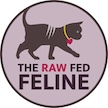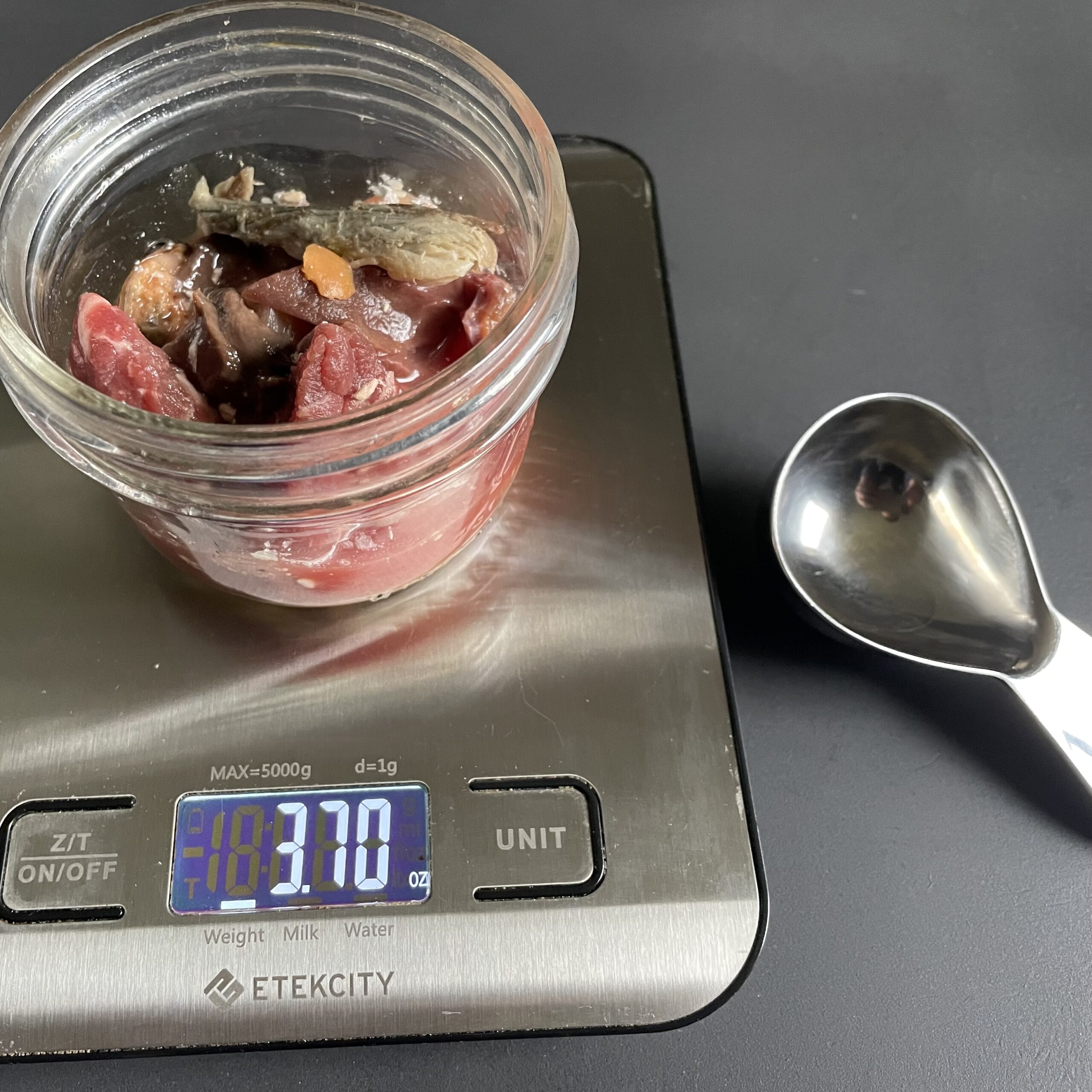An important question when raw feeding is how much to feed your cat? There are several factors to consider when determining how much raw food your cat needs. These factors can include the food being fed, the age of your cat, activity level, and any individual specific factors. Please note that this post is in reference to feeding healthy cats.
Tools needed
The first thing is that you are going to need two scales. One to weigh your cat and one to weigh your cat’s food. Baby scales work well to weigh your cat or you can use a regular scale. If your cat won’t stay still on the scale, you can weigh yourself holding your cat and then just yourself. Subtract the two numbers for your cat’s weight. It’s a very good practice to monitor your cat’s weight in general as many health related issues can manifest as a change in weight. If you have a kitten, it’s good to get them used to being weighed regularly and it’s a nice way to monitor their growth.
To weigh your cat’s food, you will need a kitchen scale. There are several simple and inexpensive digital models that you can purchase. You want to be sure that it will weigh a small enough amount. For the purposes of feeding your cat and making their food, a scale that measures weight in grams and/or ounces to the hundredths will suffice. If you will be measuring any powdered supplements, you want a jewelers’ scale, as those will measure in smaller amounts.
I like to use a 1 ounce scoop to serve food. A 1 ounce scoop is equal to 1/8 cup. These scoops can be found online, are metal, and are easy to clean and use. This way, you don’t have to weigh food every time you feed a meal to your cat, but can approximate the amount with a measured scoop.
How much: Commercial foods
When feeding commercial raw foods, the calculations for how much to feed have been done for you. There will be suggested amounts based on the weight of your cat right on the packaging. For example, the frozen raw turkey sliders from Small Batch recommend 2 sliders per 5 pounds of weight. However, sometimes the amounts suggested on commercial foods don’t meet your cat’s needs. This is where weighing your cat regularly helps. If your cat is gaining inappropriate weight at the suggested amount or always seems hungry, then you need to adjust how much you are feeding your cat based on their individual needs, not the suggested amount on the package.
How much: DIY foods
When feeding raw food that you make yourself, whether with a meat completer or from scratch, you will have to do a few calculations to figure out how much to feed your cat. Whereas with canned foods you can determine how much to feed by calories, that would become incredibly tedious with DIY foods. Every meat has a different caloric amount as well as any additional ingredients, so calculating those amounts every time is not practical. So, what do we do instead? We figure out how much raw food to feed based on percentage of body weight.
Since different meats have different calories, this means your cat is not always eating the same amount of calories with each batch of food or meal fed. This is the power of feeding a variety of foods in rotation. One meal might have more calories and another meal less. It will balance out over time if feeding a nice variety of foods.
calculations for adult cats
As I am in the US, I will use imperial units of measurement. But the concept of percentage of body weight is the same if you are using metric units (kilograms and grams). For healthy adult cats you typically feed 3% of their body weight to maintain weight. For example, Hazel weighs 9 pounds. Since I feed her food in ounces, I first convert her weight in pounds to ounces (9 X 16=144). Then I multiply Hazel’s weight in ounces by 3% (144 X 3%=4.32). This means that she will need to eat 4.32oz per day of raw food. I spread out this amount over her three daily meals.
For adult cats that need to lose some weight, you use 2% of their current body weight to help them safely and slowly lose weight. And for cats that need to gain some weight, you feed them at 4% of their body weight. In both cases, you want to weigh your cat regularly to see how they are responding to that amount of food and make any adjustments as needed.
Hairless cats, like Sphynx cats, are fed at 5-6% of their body weight. They need more energy to help them maintain their body temperature. Many cats, regardless of having fur or not, will have an increase in appetite in colder weather.
When feeding whole prey, you are still feeding based on percentage of body weight. Hazel eats whole prey daily. The animals she eats range in weight from 0.75-1.5oz. I just adjust the rest of her raw food to provide the remaining amount needed at her other meals.
kittens
Kittens are adorable little walking stomachs with paws. They can eat A LOT when they are growing. In fact, they can eat up to 10% of their body weight at times! Kittens should not have their food restricted. They are fed to appetite. This means that you offer them their raw food and let them eat as much as they need until they walk away. They have little stomachs, so you offer them multiple small meals throughout the day to support their growth. Once most cats reach 9-10 months old, they start to slow into a more adult pattern of eating.
seniors
It is also important to consider how much to feed your senior cat. Senior cats’ energy requirements actually go up around 10-12 years of age from what they needed when aged 4-9. Consequently, you want to offer seniors 10 years of age and older more food to help them maintain a healthy body mass. Again, pay attention to your senior’s weight to make any needed adjustments. This can’t be emphasized enough.
you got this
As you can see, there are a few things to keep in mind when figuring out how much raw food your cat needs. And as always, you want to pay attention to your individual cat. Just like people, cats have individual metabolisms and their needs can certainly change over time. Be sure to weigh your cat regularly and adjust as needed—you got this.


